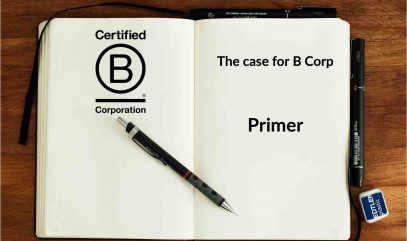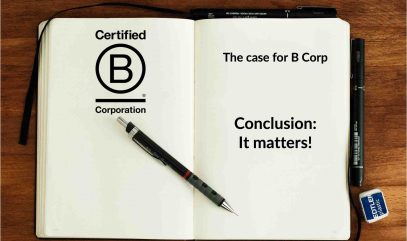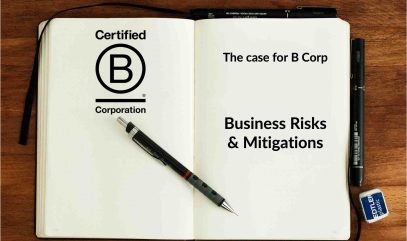Creating and Sustaining Change - Building a Culture of Sustainability
All change is challenging. Even the smallest change efforts in businesses can be difficult to accomplish. Organizational transformations, where businesses attempt to change their underlying culture and/or change their structures, can be exceedingly difficult.
It doesn’t have to be this way. There are numerous studies about how to manage change effectively. And there are some straight-forward steps that businesses can take when introducing a focus on Sustainability to improve the likelihood of success and the ability to sustain the changes once made. Here are a few of those ideas:
- Ensure the organizational structure aligns with the new change. The person responsible for Sustainability ideally should be part of the executive team and preferably report to the CEO. This demonstrates to the entire company that Sustainability is a priority and empowers the Sustainability leader. Aligning the Sustainability leader too low in the organization reduces visibility, diminishes their ability to influence other leaders, and generally signals that the changes are less important. In addition to the reporting lines for the Sustainability leader, other changes to the organizational structure may also make sense to maximize the impact of the changes your business is trying to make. Carefully consider all the leadership changes that may be necessary so that you can make all changes at the same time and reduce disruption.
- Create the necessary accountability to ensure all Leaders quickly adopt and role-model the new values. Few things sink a change effort faster than Leaders who don’t buy-in and give the impression to their teams that the change isn’t important. Culture requires everyone to be engaged, otherwise it isn’t really a culture. This means that anyone who is on the fence or fundamentally opposed to incorporating Sustainable thinking into their job likely needs to pursue new opportunities outside of your company. Or you need to bring them along quickly. The longer you wait to make these decisions, the more challenges you will experience with implementing the change.
- Embed the new values in decision making so that all employees understand how Sustainability should factor into their daily decisions and how they should weigh the various trade-offs they encounter. Disney does this exceedingly well with their Common Purpose and Quality Standards. Every Disney employee around the world knows these standards and relies on them for all their decision. Disney has four standards (in order of priority): safety, courtesy, show, and efficiency. Any decision that any employee makes is evaluated against each criterion, in order, and if the decision violates any criterion the answer is either “no” or they must find a way to ensure that their decision follows the standards. Once you start violating your standards or principles, you begin to undermine the culture you are trying to create and sustain. Creating clear guidelines takes the guess work out of the decision making and helps establish and maintain the desired culture.
- Integrate Sustainability into all performance management. This means that every employee has goals related to Sustainability in their annual objectives. Employees should have an incentive and motivation to adopt the new culture. Similarly, all processes should include targets and measurements related to Sustainability. And where necessary, processes should be revised or redesigned to ensure that Sustainability goals are achieved.
- Communicate clearly and openly. Humans need to understand how change impacts them before they can effectively embrace the changes and adapt. Employees are humans, and as such they need to understand how Sustainability relates to them, how it impacts their job, why it matters to them as an individual, and how it helps the business. We can’t expect employees to figure this out for themselves, which means that Leaders need to help their teams. The more open and transparent the communication is and the more that Leaders talk about why Sustainability is important, the easier it becomes for all employees to transition and support the common goal.
There is more to change than these few ideas. Creating a company culture that supports Sustainability, particularly a culture with aggressive targets, requires a lot of planning and coordination. Taking time to think through the change, setting clear goals, and working closely with your team(s) gets you started in the right direction. And getting the right help is always a good idea.
Overwhelmed? We’ve got this. For the good.
Note: Few books about managing and sustaining culture have resonated with me more than Be Our Guest: Perfecting the Art of Customer Service. This book details how Disney has created and sustained a culture of customer service in their theme parks and hotels, and throughout their company. While I’m generally not a big proponent of Disney, there is a lot to be learned from how they manage their company and approach culture. You can find the book at Auntie’s Bookstore in Spokane or at an independent book store in your community.
Read More
B Corps Take Climate Justice Seriously
When B Lab launched the Climate Justice Playbook for business, the B Corp community was excited. Companies understood the principles, and wanted more examples of companies implementing climate justice initiatives. The id
Case for B Corp: A Primer (Part 1)
There is strong consumer demand for products produced by companies they deem to be responsible and focused on social and environmental sustainability. In many cases, consumers will pay more for those products. Employees
Case for B Corp: It matters (Part 10)
We know that the climate is changing – 97 percent of scientists agree. While social problems are not new and have been transparent to many people, Covid-19 and racial justice protests shine a bright light on the challeng
Case for B Corp: Business Risks and Mitigations (Part 9)
Risk exists in every decision we make and every action we take as individuals. There are few things in life that don’t carry some risk. Businesses are no different – they face risks every day. And while becoming a B Corp




